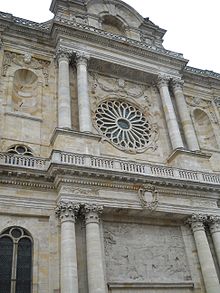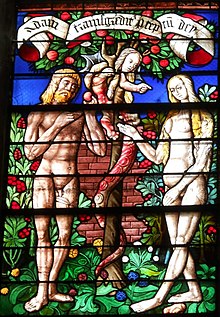Châlons-en-Champagne Cathedral
The cathedral of Châlons-en-Champagne , the former Châlons-sur-Marne, is an important Gothic church in France . As the episcopal church of the Diocese of Châlons-sur-Marne , it is dedicated to St. Etienne ( Stephanus ) consecrated.
Previous buildings
The first cathedral was built under St. Memmie, the first bishop of Châlons, built in the 4th century; she too was already dedicated to St. Dedicated to Stephan. Structurally, however, it is only the church that was built in the first half of the 12th century in the Romanesque style. On October 26, 1147 she was by the Cistercian Pope Eugene III. († 1153), a student of St. Bernhard von Clairvaux , inaugurated. In 1230 this church was destroyed by lightning and burned down; only the lower part of the north tower and parts of the crypt remained.
History of the current cathedral
The reconstruction took place a few years later, in the Gothic style, that is, with dematerialized wall surfaces in which large windows let the room appear flooded with light; the cathedral of Châlons-en-Champagne has several fine examples of medieval stained glass. Towards the end of the 13th century, the north portal on the left transept and the seven bays of the three naves were completed. The 14th century created the choir chapels and a rose window in the north transept , the 15th century continued building on the nave (three yokes). In 1520, Bishop Gilles of Luxembourg put a spike on the north tower. In the 17th century, two bays were added to the west and side chapels were built in the struts of the nave. The early classicism sat from 1628 to 1634 the western facade before; the architect was Claude Monnart . Their figurines were destroyed by the revolution.
In 1668, lightning struck the late Gothic top of the five-story north tower; she fell down, smashed the roof and the vault, and also crushed the crypt under the sanctuary. Reconstruction began in the same year.
The 19th century was marked by large-scale renovation work. The nave vaults were completely renewed and the 17th century side chapels were removed. The front wall of the south aisle was raised again. Blind arches and glass windows have been restored.
During the First World War in 1916 and 1918 bombs damaged the ambulatory and the choir chapels, and during the Second World War in 1940 and 1944 bombs destroyed the roof and the north aisle.
Some details of the construction
The three-aisled cathedral is 96.4 meters long, 28.6 meters wide and 27.08 meters high to the top of the rib vault. It has a Gothic south tower and a Romanesque north tower at the transept. The top floor of the south tower was built in 1907; its windows are modeled on the Gothic.
The only one -bay chancel is closed off by a five-part apse with three apse chapels behind. It was renewed in 1668.
The sacristy attached to the south transept is a neo-Gothic work , created by Maurice Ouradou in 1881/82.
Leaded glass window
The leaded glass windows date from the 13th to the 16th century, partly also from the Neo-Gothic period (1880) and from the 20th century.
The three windows above the main altar date from the 13th century. The central window shows Christ in glory, Christ on the cross and the Mother of God, then the deacon Stephen, St. Memmie (first bishop of Châlons) and his 8th successor, St. Alpine. The other two windows show other saints.
The front wall of the north transept, which is divided into three horizontal sections, is almost entirely taken up by window areas; Below are two large arched double windows, above six smaller double arched windows with depictions of the Twelve Apostles and above a large rosette of 24 fields. The spaces between the middle row of windows and the edge of the rosette are also shaped by medallion-like windows, depicting the triumph of Christ. The glass surfaces of the rose window and the apostle window date from the 14th century, all others are neo-Gothic from 1892.
The window in the northwest of the cathedral, a foundation of the furriers or white tanners , is again a work of the 13th century.
Windows from the 14th to 16th centuries dominate the south aisle; their motifs are the story of creation , the life of Mary and the passion . There is also a window of the saints and a window of the apostles and prophets .
Very important, because rare, are three windows from the 12th century, which restorers reassembled from individual parts in the later windows and which are exhibited in the “treasure chamber”. Among other things, they show a crucifixion scene .
Furnishing
In addition to the bishop's throne from 1822, the chancel is dominated by the high altar, which was newly erected in 1687. With its six marble columns, it is similar in structure to the half-century older Bernini canopy altar in St. Peter's Basilica in Rome and is considered to be one of the greatest altars in France. The folk altar created by Hamid Tibouchi and other furnishings in the sanctuary date from 2009.
Works of art can mainly be found in the chapels of the south aisle. A wooden statue of St. Louis from the 17th century, a holy grave from the same time as Christ, surrounded by weeping angels, a statue of "Christ in Bands" from the 16th century and a panel painting from the 15th century showing the inauguration of the Romanesque cathedral by Eugene III. shows. The wooden statue of the Virgin Mary in the Chapel is attributed to the sculptor Edmé Bouchardon from Chaumont . Another chapel contains an altar relief with the crucifixion scene, which was created in the 15th century and comes from the village church of Le Mesnil-lès-Hurlus in Champagne, which was completely destroyed in the First World War .
In the north transept there is a relief from the mausoleum of the Bishop of Châlons Jérôme Burgensis from the 16th century.
The pulpit, decorated with wooden reliefs depicting the four evangelists, was created in 1822.
A large crucifix in the north transept commemorates a mission in 1825. On the side walls are several grave monuments from the 13th to 15th centuries.
In addition to the rood screen and the choir stalls, the revolution of 1794 completely destroyed the rich sculptural decoration of the portals and converted the church into a stable. In contrast, around 90 gargoyles have survived, half human, half animal.
organ
The organ in the west of the nave was built in 1848 by the organ builder John Abbey. In 1898 the instrument was reorganized and expanded by the builder's sons. Since 1979 the organ has had the status of a "Monument Histrorique". The instrument has 54 registers , three manuals and 3,702 pipes . The choir organ was created only four years later.
|
|
|
|
||||||||||||||||||||||||||||||||||||||||||||||||||||||||||||||||||||||||||||||||||||||||||||||||||||||||||||||||||||||
Appreciation
“The cathedral of Châlons corresponds to the ideal of the Gothic. The masonry dissolves into a clear glass wall. "
literature
- Louis Rousselot: The Cathedral of Chalons-sur-Marne . 1970.
- Hubert Collin: Champagne novels . Editions Zodiaque , La Pierre-qui-Vire 1981, pp. 173-178.
- Jean-Pierre Ravaux: La cathédrale Saint-Etienne de Châlons-en-Champagne . Editions du Patrimoine, Paris 2001, ISBN 2-85822-612-1 .
- Alain Villes: La cathédrale Saint-Étienne de Châlons-en-Champagne et sa place dans l'architecture médiévale . Langres: Editions Dominique Guéniot 2006, ISBN 2-87825-226-8 review, German
- Alain Villes: La concurrence entre la cathédrale Saint-Etienne et la collégiale Notre-Dame-en-Vaux de Châlons-en-Champagne, son intérêt pour l'archéologie et l'histoire de l'art. In: Architecture and monumental sculpture of the 12th-14th centuries Century / Architecture et sculpture monumentale du 12e au 14e siècle. Production and reception. Festschrift for Peter Kurmann on his 65th birthday. Bern 2006, ISBN 3-03910-679-1 .
- Peter Kurmann: Cathedrals on pillars. On the question of a possible connection between Saint-Etienne in Châlons-en-Champagne and Altenberg. In: 1259. Altenberg and the building culture in the 13th century. ed. by Sabine Lepsky, Regensburg 2010, pp. 223–240.
Web links
- Description of the cathedral, French
- Photos of the cathedral
- The glass windows in the picture
- unofficially
Individual evidence
- ↑ Information board in front of the cathedral
- ↑ cathedrale-chalons.culture.fr
- ↑ a b c Rousselot, p. 5.
- ↑ cathedrale-chalons.culture.fr
- ↑ de.structurae.de
- ↑ cathedrale-chalons.culture.fr
- ↑ cathedrale-chalons.culture.fr
- ↑ cathedrale-chalons.culture.fr
- ↑ cathedrale-chalons.culture.fr
- ↑ Rousselot, pp. 27-30.
- ↑ cathedrale-chalons.culture.fr
- ↑ a b c cathedrale-chalons.culture.fr
- ↑ cathedrale-chalons.culture.fr
- ↑ Rousselot, p. 13.
- ↑ cathedrale-chalons.culture.fr
- ↑ kathedralen.net
- ↑ Rousselot, p. 8.
- ↑ kathedralen.net
Coordinates: 48 ° 57 '18.3 " N , 4 ° 21' 25.3" E






